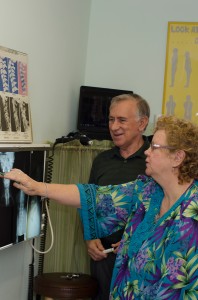Questions and Answers about Chiropractic: Round 2
 Question #1: How old is chiropractic?
Question #1: How old is chiropractic?
Answer: Chiropractic was discovered (or really rediscovered) in 1895 in Davenport, Iowa by Dr. D.D. Palmer. Dr. Palmer learned that the owner of the janitorial service in his office building had been deaf for many years after an accident. Dr. Palmer analyzed the man’s spine and located a displaced vertebra. He laid him down on a bench and gave him the world’;s first chiropractic adjustment.
The man’s hearing returned. Dr. Palmer thought he had discovered the cure for deafness but shortly thereafter Dr. Palmer had a patient suffering from heart trouble. He found a spinal distortion (subluxation) in the man’s spine, corrected it, and the heart trouble was relieved.
How could two conditions so different as deafness and heart trouble be helped by spinal adjustments? So began the birth of chiropractic. Dr. Palmer’s successes attracted people from far and wide and in time he opened the world’s first chiropractic school – The Palmer College of Chiropractic – which is in existence today.
Question # 2: What’s the #1 nutrition mistake?
Answer: Not eating nutrient dense foods. Some foods give you an abundance of life-sustaining nutrients – these are known as “nutrient dense” foods. Other so-called “foods” have no nutritional value or even negative nutritional value – they drain you of nutrients. These are processed “junk foods”manufactured with sugar, high fructose corn syrup, hydrogenated or partially hydrogenated vegetable oil and white flour.
 Soda (pop), margarine, canola oil are toxic and artificial sweeteners such as NutraSweetT (aspartame), Splenda and Equal are linked to brain tumors, memory loss and vision damage.
Soda (pop), margarine, canola oil are toxic and artificial sweeteners such as NutraSweetT (aspartame), Splenda and Equal are linked to brain tumors, memory loss and vision damage.
GM or genetically-modified foods are to be avoided. Soy is especially unhealthy because it is often genetically modified, difficult to digest and affects the thyroid and hormones. Exceptions are fermented soy products such as soy sauce, natto, tempeh and miso.
Nutrient dense foods include healthy fats and oils (olive oil, coconut oil, butter, tallow, duck fat, lard), grass-fed beef and non-pasteurized raw milk and raw milk products. Bone and chicken broths are excellent sources of minerals and trace elements. Also make sure your food is certified organic. Organic foods have far less toxic pesticides, fungicides and herbicides than conventional foods.

No comments yet.